IJCRR - Vol 09 issue 10 current issue , May, 2017
Pages: 53-57
Date of Publication: 27-May-2017
Print Article
Download XML Download PDF
Energy Efficient Greedy Algorithm for Wireless Mesh Networks
Author: Veenu Mor, Harish Kumar
Category: Technology
Abstract:Aim: Wireless Mesh Networks (WMN's) are gaining recognition among users. But WMN resources are not always utilized up to their full capacity. Redundant links and nodes can be turned in low power state for energy savings. WMN's build on IEEE 802.11s, supports link based power saving mode (PSM). But IEEE 802.11s standard does not specify switching among PSM. This research work provides a greedy approximation algorithm to allow redundant nodes and links in low power state to achieve minimum energy consumption.
Methodology: Proposed algorithm is based on traffic consolidation over few nodes, subject to available link slots due to wireless interference. This will permit redundant nodes in deep sleep mode.
Results: Analysis reveals that choosing power saving mode carefully of peer links can achieve great energy efficiency.
Conclusion: Results signifies that energy saving comes with cost of delay. So traffic consolidation based approaches are more suitable for delay tolerant networks.
Keywords: Energy Efficient, Wireless Mesh Network, Power Saving Mode, Greedy Approach, Traffic Consolidation
Full Text:
INTRODUCTION
With increasing usage to digital devices and need of access toInternet from anywhere, Wireless Mesh Networks (WMN’s) are gaining popularity among community. WMN can be designed based on various wireless standards like IEEE 802.11a/b/g/s IEEE 802.16, IEEE 802.15 etc. IEEE 802.11s is specially designed to support features of WMN. Unlike previous standard of IEEE 802.11, IEEE 802.11s supports link based power saving mode (PSM) namely light sleep mode, deep sleep mode, and active mode. PSM of link of a node can be chosen independent of PSM value of other links. But standard itself does not specify PSM switch criteria. In order to save network energy a feasible approach is desired so that redundant resources can be switched in low power state. To identify and allow redundant nodes in low power state, by solving mathematical problem as mixed linear programming problem [1-2] can be computationally expensive and practically not feasible. A greedy algorithm as an approximation to optimized solution can be a valuable approach. The energy aware greedy routing algorithm based on resource consolidation, subject to available link slots due to wireless interference has been proposed. Traffic consolidation is an approach where traffic of several underutilized nodes is consolidated to few active nodes. Algorithm will allow many nodes i in doze state so that system capacity could be utilized efficiently. The performance of the proposed algorithm has been evaluated and analyzed. The remaining of text is structured as follows. Section II presents related area of work, Section III presents greedy algorithm to achieve PSM for links to let maximum nodes in deep sleep mode. Section IV gives results and Section V provides the discussion. Finally, concluding remarks are presented in section VI.
Related Works
Energy Efficient WMN is active area of studies, number of research work exist in literature. Ashraf [3] has proposed a heuristic based greedy algorithm for placement of gateway in WMN in energy efficient way. The known traffic demands are satisfied while minimizing the overall energy usage of the network. Yu et al. [4] have given energy-aware design of the network selection, sub channel, and power assignment in cellular and Wi-Fi networks. Researchers in [3-4] have focused on energy minimization by network designing. While authors in [5] reduces energy consumption by accessing information of medium access layer via control packet. In [6] authors have enhanced the network life time by shutting down the unnecessary nodes. The nodes to be shutdowns are identified based on threshold distance. A node can decide to shutdown itself if its distance to neighbor node is within threshold distance. Performance of network highly depends on selected value for threshold distance. Ismail et al. [7] have given cooperation based approach so that networks with overlapping coverage may cooperate to let others switch off. But traffic consolidation subject to link availability has not been given due considerations. Keeping in view of growing interest in energy efficient WMN this research work focuses at providing greedy algorithm to consolidate the determined traffic over few nodes in energy efficient way subject to link slot availability

Research Methodology
A greedy algorithm has been proposed for network having nodes with sufficient power supply. Here objective is to reduce energy consumption of overall network
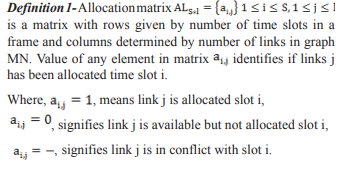

Energy_Aware_Resource_Consolidation (Algorithm 1) consolidates the traffic over minimum number of nodes in energy efficient way, to allow maximum number of links and nodes in energy saving mode. Load is redistributed by cooperation among neighbor nodes to let maximum link and nodes in low power state. Under law of wireless interference, algorithm firstly computes shortest path in term of energy towards gateway nodes using Minimum_Energy_Route (Algorithm 2). Active degree of any nodes is computed based on incoming {1i, j } /outgoing links {1j, i}, which in turn is given by number of 1 in corresponding column on ALs*1. Redundant nodes identified using step 2 and 3 are set in doze state and their associated links in deep sleep mode. A list of nodes in increasing order of load is computed. For traffic consolidation, least loaded node is picked for adjustment of their traffic over existing active nodes. Based on greedy assumption that re-adjustment of lower loaded nodes will be more feasible and beneficial in terms of energy. If load can’t be adjusted then traffic of next least loaded node in list is readjusted and so on till we reach at end of list. If all traffic of such node can be rerouted successfully then least loaded node is set to doze state and their associated links in deep sleep mode. Then updated list of nodes is sorted in increasing order of load. Minimum_Energy_Route (Algorithm 2) finds best available route with minimum energy consumption based on available slots as per law of wireless interface under single channel. Algorithms 3 address feasibility of traffic on a link to be routed.
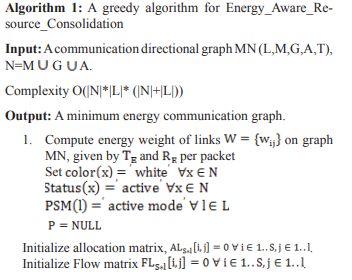


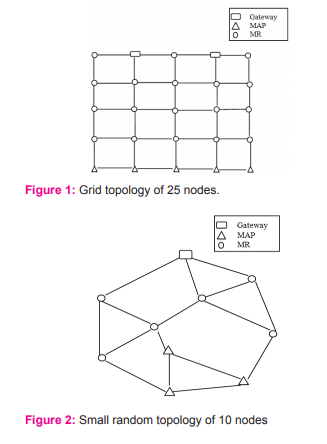
RESULTS
Algorithm has been implemented in C++. Multiple runs reveal that algorithm is energy efficient. 30 slots per frame have been assumed for simulation. Let energy used in transmitting a packet is 3.1 mJ, energy used in receiving a packet is 0.2 mJ, and energy consumption of an MR is 15W. Considering network topology given in figure 1 and 2. Let network have single channel to operate. As per law of wireless interference network will be highly congested if traffic at all MAP’s exceed 10 packets. Results for random and grid topology are given in Table 1 and Table 2.
DISCUSSION
By reducing redundant peer links energy saving can be enhanced in 802.11s. Analysis reveals that choosing PSM carefully of peer links can achieve great energy efficiency. As solving the optimization problem can be computationally expensive. So, greedy based approach can be very effective. During low traffic period more resources are underutilized, so algorithm can let more links and nodes in deep sleep mode. But when traffic is close to peek level, resources are utilized up to their maximum capacity and percentage of energy saving reduces.
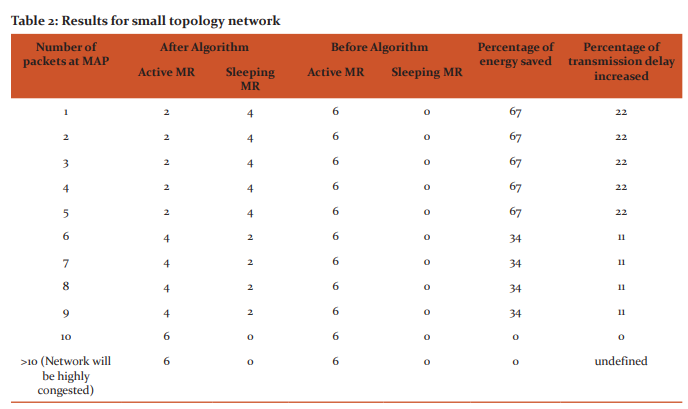
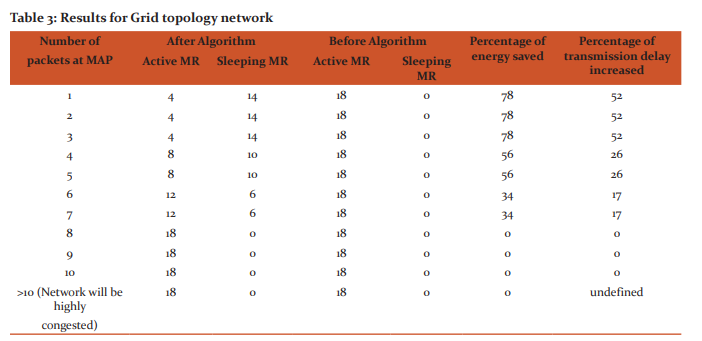
CONCLUSION
This work represents importance of wireless mesh network in today network. PSM of IEEE 802.11s can achieve great energy saving. According to IEEE 802.11s standard a mesh node may choose to enter in doze state (in doze state a mesh node may switch off the transceivers) for power saving only if the mesh STA operates in light sleep mode or deep sleep mode for all of its mesh peering. A greedy algorithm has been proposed to minimize energy consumption. Results reveal that algorithm is effective in reducing energy consumption of network, but comes with cost of increase in traffic delay. So traffic consolidation approaches are more suitable for delay tolerant network.
ACKNOWLEDGEMENT
Authors acknowledge the immense help received from the scholars whose articles are cited and included in references of this manuscript. The authors are also grateful to authors / editors / publishers of all those articles, journals and books from where the literature for this article has been reviewed and discussed. Source of Funding: Nil Conflict of Interest: Nil
References:
- Capone A, Malandra F, Sansò B. Energy Savings in Wireless Mesh Networks in a Time-Variable Context. Mobile Networks and Applications. 2012; 17(2), 298-311.
- Mamechaoui S, Senouci SM, Didi F, Pujolle G. Energy Efficient Management for Wireless Mesh Networks with Green Routers. Mobile Networks and Applications.2015; 20, 567–582.
- Ashraf U. Energy-Aware Gateway Placement in Green Wireless Mesh Networks. IEEE Communications Letters. 2017 Jan; 21(1), 156-159. doi: 10.1109/LCOMM.2016.2618378
- Yu H, Cheung MH, Huang L, Huang J. Power-Delay Tradeoff With Predictive Scheduling in Integrated Cellular and Wi-Fi Networks. IEEE Journal on Selected Areas in Communications. 2016 April, 34(4), 735-742. doi: 10.1109/JSAC.2016.2544639
- Song Y, Ciubotaru B, Muntean GM. A Cross-Layer Quality-Oriented Scheme for Energy-Efficient Multimedia Delivery in Wireless Networks. IEEE Transactions on Vehicular Technology.2016 Oct; 65(10), 8554-8566.
doi: 10.1109/TVT.2015.2504390
- Hepner C, Muenzner R. Lifetime enhancement of disaster recovery systems based on IEEE 802.11s wireless mesh networks. 2015 IEEE 11th International Conference on Wireless and Mobile Computing, Networking and Communications (WiMob), Abu Dhabi, 2015;. 91-99. doi: 10.1109/WiMOB.2015.7347945
- Ismail, M., Zhuang, W. Network Cooperation for Energy Saving in Green Radio Communications. IEEE Wireless Communication.2012; 18(5):76-81.
- Hochbaum, D.S. Complexity and algorithms for nonlinear optimization problems. Annals of Operations Research, 2007; 153 (1): 257-296.
|






 This work is licensed under a Creative Commons Attribution-NonCommercial 4.0 International License
This work is licensed under a Creative Commons Attribution-NonCommercial 4.0 International License